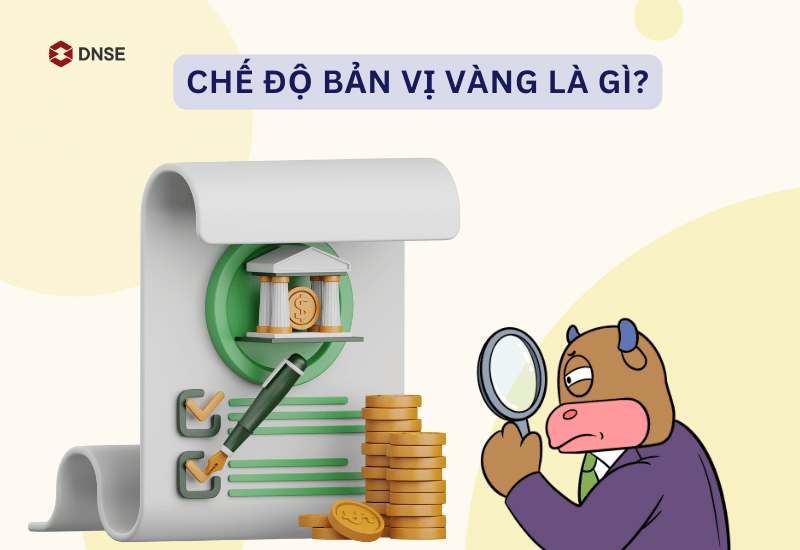
What is the gold standard? Collapse of the Gold Standard
The gold standard, an international financial standard that once dominated the global economy, was based on the use of gold as the basis for money supply and exchange rate valuations.
What is the gold standard?
The gold standard (or Gold Standard) is a monetary system in which the value of a country’s currency is valued based on a certain amount of gold.
In this regime, countries pledged to swap their paper currencies for gold at an agreed fixed rate.
Each country sets a fixed price for gold and maintains gold trading at this price. This fixed price is then used as the basis for determining the value of the national currency, ensuring stability and predictability for the economy.
Characteristics of the gold standard regime
- The government commits to people being able to convert money into gold or vice versa at any time.
- Thanks to the gold standard, countries cannot arbitrarily print more paper money. This helps stabilize the value of money, minimizing inflation.
- People trust money more and more and are willing to exchange gold for money. When people use money, it will help promote buying and selling of goods, stimulating economic growth.
 Gold is the guarantee to print currency
Gold is the guarantee to print currency
Advantages and disadvantages of the gold standard
Advantage:
- The gold standard helps stabilize the value of currencies because the value of gold is relatively less volatile.
- Gold is widely accepted around the world, easily becoming a means of exchange.
- Countries participating in the gold standard were required to adhere to strict financial rules to maintain fixed exchange rates with gold. This helps limit inflation and protect consumers’ purchasing power.
- This system facilitates global trading without concerns about exchange rate risk, thanks to countries using currencies valued at gold.
Defect:
- The amount of gold is limited so there is a shortage of supply. Commodity prices are increasingly increasing with the development of the economy combined with speculation and hoarding of gold. This causes the Government to raise gold prices to meet transaction demand.
- The currency’s ability to expand is limited by the amount of gold, limiting its ability to meet the needs of economic growth.
- The gold standard was not equipped to deal with major recessions or deflation. The rigidity of gold will make the economy less flexible, not creating money supply and fiscal policy.
The history and collapse of the gold standard

Relations between states and regime collapse
During the 1st and 2nd world wars
- In 1821, Great Britain pioneered the use of the gold standard and spread it to European countries. America is said to be the latest country to use the capitalist system.
- In 1874, this regime became popular and flourished nationwide, and gold prices were always kept at a stable level. Countries applying the gold standard have coordinated trade with each other very well.
- 1914 – 1944: After going through the first and second world wars, countries desperately needed cash to restore their economies. While gold is becoming increasingly rare, the amount of money printed is not enough to meet actual demand. Although the gold standard was not abolished during this period, it gradually degraded and was no longer suitable.
After World War II
- In both world wars, the United States was the country that benefited the most. At this time, the US occupied 3/4 of global gold reserves, the remaining ¼ was divided equally among the world. After the war, Europe was left with almost nothing. At this time, America had a lot of gold, so it was allowed to print a lot of dollars. Therefore, the US lent money to European countries to recover economically after the war.
- 1944: The main powers, including the US, UK, and France, met to propose a new monetary system, Bretton Woods, the “dollar standard”. World currencies will be backed by dollars and dollars will be backed by gold. At this time, the USD was anchored to gold with a value of 35 USD = 1 ounce.
- Due to this increased demand for USD, the US has been printing a lot of money and there is no set gold reserve ratio. Such reckless printing of money has made Europe feel uneasy. Therefore, many European countries sold dollars to buy back gold. The US had to exchange 50% of its existing gold and the amount of money sent back to the US to exchange for gold was 12 times the amount of gold the US currently had.
- 1971: US President Nixon abolished the Gold Standard from the dollar. This means the dollar’s fixed value is removed, allowing it to float on the market. The immediate consequence is that the USD loses value.
- 1973: The gold standard officially collapsed worldwide.
Fiat Money – An alternative to the gold standard
What is fiat money?
Today, countries around the world are abandoning the gold standard and replacing it with fiat currencies.
Fiat money is a currency issued by a country’s government and is not backed by any physical commodity such as gold or silver.
Without intrinsic value, fiat money can still ensure its role as an official means of payment, accepted in all economic and social transactions within that country. The stability and value of fiat currency depends on the economic policy, monetary management of the central bank, and the political stability of the issuing country.

Legal currency of each country
For example, the US Dollar (USD), Euro (EUR), and Vietnamese Dong (VND) are examples of fiat currencies. The value of these currencies is not based on physical assets such as gold or silver but depends on the support and guarantees of the governments of the issuing countries.
Advantages and disadvantages of fiat money
Advantage:
- Stability and control : Fiat money allows the state and central bank to flexibly adjust the money supply, helping to manage the economy more effectively.
- Low issuance costs : Issuing fiat currency is less expensive than maintaining reserves of gold or precious metals.
- Convenient for international trade : Due to its widespread acceptance, fiat money makes international transactions more convenient.
- No dependence on gold reserves : This reduces dependence on limited resources and price fluctuations of gold.
Defect:
- Inflation risk : Unlimited money printing can lead to inflation, reducing the value of currency.
- Damaged underlying value : Increasing the money supply can weaken currency value and cause economic instability.
- Dependence on Government : Stability and trust in fiat currencies depend largely on the stability and credibility of the government.
- Lack of transparency and human influence : Because control mainly lies with the state, fiat currencies can be influenced by political decisions, lacking transparency and fairness.
These factors need to be carefully considered to ensure stability and sustainable development of the economy.


